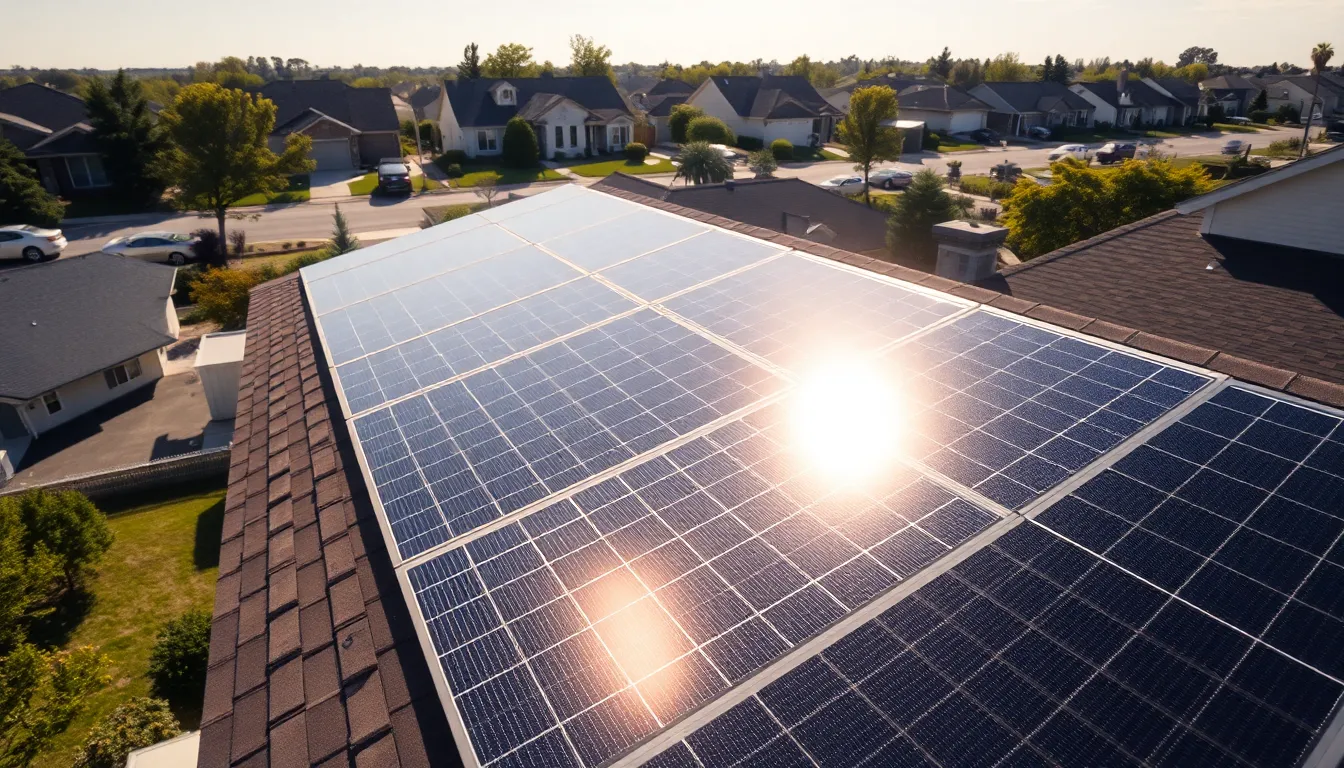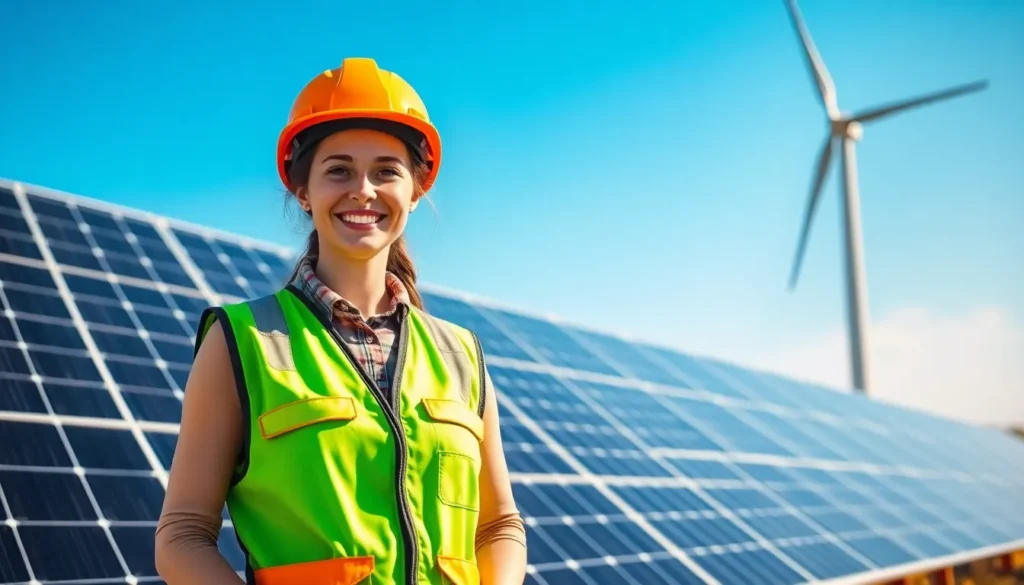Table of Contents
ToggleIn a world where “going green” is more than just a catchy slogan, sustainable energy technology is the superhero we never knew we needed. Picture this: a planet powered by sunshine, wind, and the occasional high-five from Mother Nature. It’s not just a dream; it’s becoming a reality, and it’s time to get on board before the fossil fuels throw a tantrum.
With innovations popping up faster than a cat video on the internet, sustainable energy technology is changing the game. From solar panels that practically pay for themselves to wind turbines that could make even the grumpiest of neighbors smile, the future looks bright—literally. So, let’s dive into this electrifying world where eco-friendliness meets cutting-edge technology, and discover how it’s reshaping our lives for the better.
Overview of Sustainable Energy Technology
Sustainable energy technology encompasses a range of innovations aimed at reducing dependence on fossil fuels. Renewable energy sources like solar, wind, and hydro power serve as primary drivers of this shift. Each technology contributes unique benefits toward creating a cleaner environment.
Solar energy systems capture sunlight using photovoltaic panels, converting it into electricity. Wind turbines harness wind flow to generate power, representing another efficient method for energy production. Hydropower relies on flowing water to produce energy, often providing a consistent and stable power source.
Advanced energy storage solutions also enhance the effectiveness of renewable technologies. Battery storage systems allow for excess energy to be stored and used during periods of high demand. This capability ensures a more reliable energy supply.
Smart grid technology plays a critical role in the management of energy distribution. It enables efficient energy usage by optimizing the flow of electricity from various sources. Consumers gain the ability to monitor and control their energy consumption, leading to more sustainable practices.
Additionally, bioenergy presents opportunities to utilize organic materials for power generation. This approach includes converting agricultural waste and other biomass into usable energy forms.
As a result of these advancements, the landscape of energy production is changing. Public and private investments continue to foster growth in these technologies. Stakeholders committed to sustainability can contribute to a more resilient energy future, promoting both environmental responsibility and economic stability.
Types of Sustainable Energy Technologies

Sustainable energy technologies encompass various innovations reshaping energy production. These include solar energy solutions, wind energy innovations, and biomass along with biofuels.
Solar Energy Solutions
Solar energy solutions convert sunlight into electricity using photovoltaic (PV) systems. These systems rely on solar panels that absorb sunlight and generate power effectively. Concentrated solar power (CSP) systems, meanwhile, use mirrors to focus sunlight, producing heat for energy generation. Increased efficiency in solar cell technology reduces costs for consumers while boosting installation rates. The integration of solar energy into residential and commercial properties promotes energy independence and decreases reliance on fossil fuels.
Wind Energy Innovations
Wind energy innovations harness wind movement to produce clean energy. Towers with large blades capture wind flow, spinning turbines to generate electricity. Advances in turbine design enhance energy output even in low-wind conditions. Offshore wind farms feature larger turbines that benefit from stronger, steadier winds. Such projects contribute significantly to national energy goals, creating jobs while reducing greenhouse gas emissions.
Biomass and Biofuels
Biomass and biofuels offer alternative fuel sources derived from organic materials. These materials include agricultural waste, wood chips, and even municipal solid waste. Converting biomass into electricity helps reduce reliance on fossil fuels while providing a renewable energy source. Biofuels can power vehicles and machinery, substituting traditional gasoline and diesel. This approach promotes a circular economy, as waste materials are repurposed into usable energy.
Benefits of Sustainable Energy Technology
Sustainable energy technology offers numerous advantages that impact the environment and economy positively.
Environmental Impact
Sustainable energy technologies reduce greenhouse gas emissions significantly. Solar, wind, and hydropower harness natural resources without depleting them. These renewable sources contribute to cleaner air and water, promoting biodiversity. Advanced energy solutions also minimize habitat destruction compared to fossil fuel extraction. Furthermore, sustainable practices encourage energy conservation and pollution reduction. Each technology plays a unique role in combating climate change, making a substantial difference in preserving the planet for future generations.
Economic Advantages
Investment in sustainable energy creates job opportunities across various sectors. The renewable energy industry employed over 3 million individuals in the U.S. by 2020, a number that continues to grow. Cost reductions in solar panels and wind turbines lead to lower energy prices for consumers. Long-term savings also arise from decreased dependence on fossil fuels, boosting energy security. Additionally, sustainable energy technologies stimulate local economies through infrastructure development and innovation. These economic benefits enhance resilience and sustainability in energy systems.
Challenges in Implementing Sustainable Energy Technology
The transition to sustainable energy technology faces several challenges. These obstacles hinder rapid adoption and widespread benefits.
Technological Barriers
Limited infrastructure poses a significant challenge. Many regions lack the necessary facilities to support renewable energy sources. High initial costs often deter investment in newer technologies. Not all renewable energy systems provide consistent power output, creating reliability issues. Advanced energy storage solutions are not universally accessible, complicating the integration of renewables into existing grids. Maintenance expertise for complex systems remains scarce, affecting operational efficiency.
Policy and Regulatory Issues
Inconsistent policies create uncertainty for investors. Different states and countries enforce varying regulations, complicating cross-border energy projects. Limited government incentives for renewable energy schemes impact overall growth. Some regulatory frameworks favor fossil fuels, impeding the competitiveness of sustainable technologies. Public opposition and NIMBYism can lead to delays in project approvals. Clear, supportive policies are crucial for fostering investment in sustainable energy technology.
Future Trends in Sustainable Energy Technology
Sustainable energy technology continues to evolve, creating new opportunities to harness renewable resources effectively. Innovations on the horizon promise to reshape the energy landscape.
Emerging Technologies
Advancements in energy technologies enhance efficiency and reduce costs. Perovskite solar cells, known for their high efficiency and lower production costs, are a significant breakthrough. Floating wind farms utilize ocean currents to capture wind energy more effectively than traditional land-based turbines. Additionally, hydrogen fuel cells gain traction as a clean alternative for energy storage and transportation. Other innovations, including advanced geothermal systems, leverage Earth’s heat to generate power. These technologies aim to deliver more reliable and accessible renewable energy solutions.
Global Initiatives
Global initiatives play a key role in promoting sustainable energy technologies. The Paris Agreement encourages countries to commit to reducing carbon emissions through cleaner energy sources. Organizations like the International Renewable Energy Agency (IRENA) support collaboration and knowledge sharing among nations. Various countries implement ambitious policies aimed at transitioning to renewables, such as Germany’s Energiewende and China’s investments in solar energy. Furthermore, financial incentives, such as grants and tax breaks, stimulate private sector participation in sustainable projects. Such measures drive the global shift toward a more resilient energy future.
The shift toward sustainable energy technology represents a pivotal moment in the quest for a cleaner planet. By embracing renewable sources like solar, wind, and hydropower, society can significantly reduce its environmental footprint while fostering economic growth. Innovations in energy storage and smart grid technology further enhance the reliability and efficiency of these systems.
However, overcoming the challenges of infrastructure and policy is crucial for widespread adoption. Continued investment and collaboration among governments, businesses, and communities will pave the way for a resilient energy future. As the world navigates this transition, the commitment to sustainable practices will not only benefit the environment but also create a more sustainable economy for generations to come.




